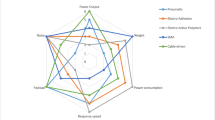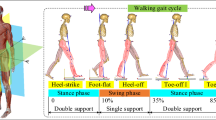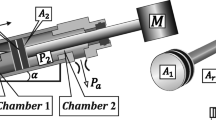Abstract
Juggling a devil-stick can be described as a problem of non-prehensile manipulation. Assuming that the devil-stick remains confined to the vertical plane, the problem of juggling the stick between two symmetric configurations is considered. Impulsive forces are applied to the stick intermittently and the impulse of the force and its point of application are modeled as control inputs to the system. The dynamics of the devil-stick due to the impulsive forces and gravity is described by half-return maps between two Poincaré sections; the symmetric configurations are fixed points of these sections. A coordinate transformation is used to convert the juggling problem to that of stabilization of one of the fixed points. Inclusion of the coordinate transformation in the dynamic model results in a nonlinear discrete-time system. A dead-beat design for one of the inputs simplifies the control problem and results in a linear time-invariant discrete-time system. Standard control techniques are used to show that symmetric juggling can be achieved from arbitrary initial conditions.









Similar content being viewed by others
Notes
It is assumed that the initial conditions of the devil-stick are such that its trajectory intersects one of the two Poincaré sections before the first impulsive control input is applied.
A detailed discussion of MPC design for discrete-time systems can be found in Chapters 1-3 in [36].
The augmented state-space model is controllable; this was verified using Theorem 1.2 in [36].
It should be noted that the state variables are shown in the reference frame of the right-handed juggler.
The quadprog MATLAB function was used.
References
HNWpodcasts. Five easy devil stick tricks with instructions. https://www.youtube.com/watch?v=Z7Pv-p-nEYo, (2013). [Online Accessed 01 May 2020]
Duinker, N.: Devilstick tutorial—basic tricks to get you started. https://www.youtube.com/watch?v=MAuAtwZ7BF4, (2015). [Online Accessed 01 May 2020]
Lynch, K.M., Mason, M.T.: Dynamic underactuated nonprehensile manipulation. In Proceedings of IEEE/RSJ international conference on intelligent robots and systems. IROS’96. IEEE, vol 2, pp 889–896 (1996)
Lynch, K.M., Mason, M.T.: Dynamic nonprehensile manipulation: controllability, planning, and experiments. Int. J. Robot. Res. 18(1), 64–92 (1999)
Lynch, K.M., Murphey, T.D.: Control of nonprehensile manipulation. In: Control problems in robotics. Springer, pp 39–57(2003)
Mason, M.T.: Progress in nonprehensile manipulation. Int. J. Robot. Res. 18(11), 1129–1141 (1999)
Woodruff, J.Z., Lynch, K.M.: Planning and control for dynamic, nonprehensile, and hybrid manipulation tasks. In: 2017 IEEE international conference on robotics and automation (ICRA). IEEE, pp 4066–4073 (2017)
Brogliato, B., Rio, A.Z.: On the control of complementary-slackness juggling mechanical systems. IEEE Trans. Autom. Control 45(2), 235–246 (2000)
Hirai, H., Fumio, M.: Dynamic coordination between robots: self-organized timing selection in a juggling-like ball-passing task. IEEE Trans. Syst. Man Cybern. Part B (Cybernetics) 36(4), 738–754 (2006)
Kober, J., Glisson, M., Mistry, M.: Playing catch and juggling with a humanoid robot. In: 12th IEEE-RAS international conference on humanoid robots (Humanoids 2012). IEEE, pp 875–881 (2012)
Zavala-Rio, A.: Brogliato, Bernard: on the control of a one degree-of-freedom juggling robot. Dyn. Control 9(1), 67–90 (1999)
Brogliato, B.: Feedback control of multibody systems with joint clearance and dynamic backlash: a tutorial. Multibody Syst. Dyn. 42(3), 283–315 (2018)
Brogliato, B., Mabrouk, M., Rio, A.Z.: On the controllability of linear juggling mechanical systems. Syst. Control Lett. 55(4), 350–367 (2006)
Goebel, R., Sanfelice, Ricardo, G., Teel, Andrew R.: Hybrid dynamical systems: modeling stability, and robustness, (2012)
Lynch, K.M., Black, C.K.: Recurrence, controllability, and stabilization of juggling. IEEE Trans. Robot. Autom. 17(2), 113–124 (2001)
Tornambe, Antonio: Modeling and control of impact in mechanical systems: theory and experimental results. IEEE Trans. Autom. Control 44(2), 294–309 (1999)
Zavala-Rio, A., Brogliato, B.: Direct adaptive control design for one-degree-of-freedom complementary-slackness jugglers. Automatica 37(7), 1117–1123 (2001)
Ronsse, R., Lefevre, P., Sepulchre, R.: Rhythmic feedback control of a blind planar juggler. IEEE Trans. Robot. 23(4), 790–802 (2007)
Sanfelice, R.G., Teel, A.R., Sepulchre, R.: A hybrid systems approach to trajectory tracking control for juggling systems. In: 46th IEEE conference on decision and control. IEEE, pp 5282–5287 (2007)
Schaal, S., Atkeson, C.G.: Open loop stable control strategies for robot juggling. In: Proceedings IEEE international conference on robotics and automation. IEEE, pp 913–918 (1993)
Spong, M.W.: Impact controllability of an air hockey puck. Syst. Control Lett. 42(5), 333–345 (2001)
Nakaura, S., Yasuyuki, K., Tadasuke, M., Mitsuji, S.: Enduring rotary motion control of devil stick. IFAC Proc. Vol. 37(13), 805–810 (2004)
Shiriaev, A., Robertsson, A., Freidovich, L., Johansson, R.: Generating stable propeller motions for devil stick. In: 3rd IFAC workshop on Lagrangian and Hamiltonian methods for nonlinear control, 2006, (2006)
Brogliato, B.: Nonsmooth Mechanics. Models Dynamics and Control. Springer Nature, Switzerland AG (2016)
Kant, N., Mukherjee, R., Khalil, H. K.: Stabilization of homoclinic orbits of two degree-of-freedom underactuated systems. In: 2019 American Control Conference (ACC), (2019)
Kant, N., Ranjan, M.: Impulsive dynamics and control of the inertia-wheel pendulum. IEEE Robot. Autom. Lett. 3(4), 3208–3215 (2018)
Kant, N., Mukherjee, R.: Orbital stabilization of underactuated systems using virtual holonomic constraints and impulse controlled Poincaré maps. Syst. Control Lett. 146, 104813 (2020)
Kant, N., Mukherjee, R., Chowdhury, D., Khalil, H.K.: Estimation of the region of attraction of underactuated systems and its enlargement using impulsive inputs. In: IEEE transactions on robotics, pp 1–15, (2019)
Mathis, F.B., Rouhollah, J., Mukherjee, R.: Impulsive actuation in robot manipulators: experimental verification of pendubot swing-up. IEEE/ASME Trans. Mechatron. 19(4), 1469–1474 (2014)
Grizzle, J.W., Abba, G., Plestan, F.: Asymptotically stable walking for biped robots: analysis via systems with impulse effects. IEEE Trans. Autom. Control 46(1), 51–64 (2001)
Westervelt, E.R., Grizzle, J.W., Koditschek, D.E.: Hybrid zero dynamics of planar biped walkers. IEEE Trans. Autom. Control 48(1), 42–56 (2003)
Wiggins, S.: Introduction to Applied Nonlinear Dynamical Systems and Chaos. Springer Science & Business Media, Berlin (2003)
Bold, K., Edwards, C., Guckenheimer, J., Guharay, S., Hoffman, K., Hubbard, J., Oliva, R., Weckesser, W.: The forced van der Pol equation II: canards in the reduced system. SIAM J. Appl. Dyn. Syst. 2(4), 570–608 (2003)
Guckenheimer, J., Hoffman, K., Weckesser, W.: The forced van der Pol equation I: the slow flow and its bifurcations. SIAM J. Appl. Dyn. Syst. 2(1), 1–35 (2003)
Antsaklis, P.J., Michel, A.N.: A Linear Systems Primer. Birkhauser, Basel (2007)
Wang, L.: Model Predictive Control System Design and Implementation Using MATLAB. Springer Science & Business Media, Berlin (2009)
Acknowledgements
The authors acknowledge the support provided by the National Science Foundation, Grant CMMI-1462118.
Author information
Authors and Affiliations
Corresponding author
Ethics declarations
Conflict of interest
The authors declare that they do not have any conflict of interest.
Additional information
Publisher's Note
Springer Nature remains neutral with regard to jurisdictional claims in published maps and institutional affiliations.
Rights and permissions
About this article
Cite this article
Kant, N., Mukherjee, R. Non-prehensile manipulation of a devil-stick: planar symmetric juggling using impulsive forces. Nonlinear Dyn 103, 2409–2420 (2021). https://doi.org/10.1007/s11071-021-06254-0
Received:
Accepted:
Published:
Issue Date:
DOI: https://doi.org/10.1007/s11071-021-06254-0




